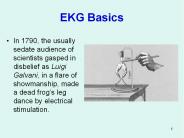The Basics of Electricity - PowerPoint PPT Presentation
1 / 8
Title:
The Basics of Electricity
Description:
The Basics of Electricity Current and Voltage An electric current is the movement of electrons ( negative charges ). Current is measured in units called Amps ( A ). – PowerPoint PPT presentation
Number of Views:247
Avg rating:3.0/5.0
Title: The Basics of Electricity
1
The Basics of Electricity
Current and Voltage An electric current is the
movement of electrons ( negative charges ).
Current is measured in units called Amps ( A
). In a conductor ( all metals, carbon ) the
electrons are free to move. If the conductor is
connected to a voltage supply ( mains, battery )
the electrons are given the energy they need to
move. Voltage is measured in units called Volts (
V ).
2
Appliances The mains and a battery supply
electrical energy. Appliances change this
electrical energy to another form. Some typical
main energy changes that take place in everyday
appliances Aplicación Energy
Change Kettle Lamp Radio Food Mixer
3
Power The Power of an appliance tells us how
quickly it uses up electrical energy. Power is
measured in units called Watts ( W ). High Power
appliances need a bigger electric current.
4
Fuses
- Every appliance has a fuse ( usually found in its
plug ). - The fuse protects the flex connecting the
appliance from overheating. - If too large a current flows through the flex the
fuse melts. - The gap created means no current can flow and the
appliance is safe. - Appliances usually need a 3 A or a 13 A fuse.
- These are the maximum currents that can flow
before the fuse melts.
5
(No Transcript)
6
What energy do appliances with the biggest Powers
produce? What size of fuse do appliances with a
Power greater than 700 W need? What about
appliances with a Power less than 700 W? What
appliances are exceptions to this rule? Why do
these appliances require a bigger fuse?
Heat Energy appliances have the biggest
Powers Power more than or equal to 700 W needs
a 13 A fuse Power less than 700 W needs a 3 A
fuse Fridge and a hoover are exceptions They
both have an electric motor
7
Choosing a Fuse Appliances with a power rating
up to 700 W use a 3A fuse Appliances with a
power rating greater than 700 W use a 13 A fuse
8
Flexes
- A flex connects an appliance to a plug.
- Appliances with a bigger power require a thicker
flex.
Appliance Flex Thickness (mm2)
500 W Food Mixer 1000 W Toaster 3000 W Kettle 0.5 0.75 1.25































